The chefs at Kiawah Island Golf Resort and a recipe for Palmetto Quail from Jasmine Porch
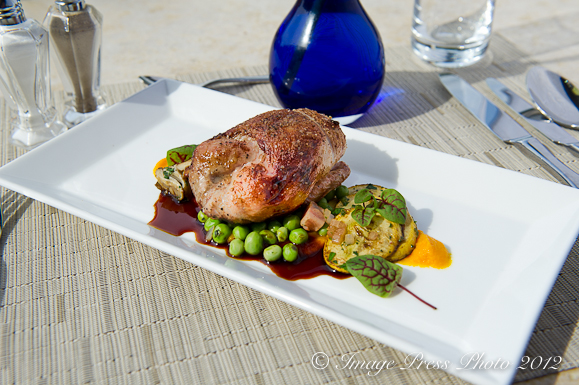
We recently traveled to Kiawah Island, South Carolina to work with the culinary team at Kiawah Island Golf Resort. Just thirty minutes south of Charleston, you are immediately immersed in the beauty and solitude of this special island upon your arrival. As you drive toward The Sanctuary, the smell of the ocean settles in and you are surrounded by spectacular beaches, native plant life and flowers and perhaps, even an alligator or two along the way. The developers of Kiawah Island have focused on coexisting with the indigenous wildlife and preserving the natural beauty of the island. They have succeeded.
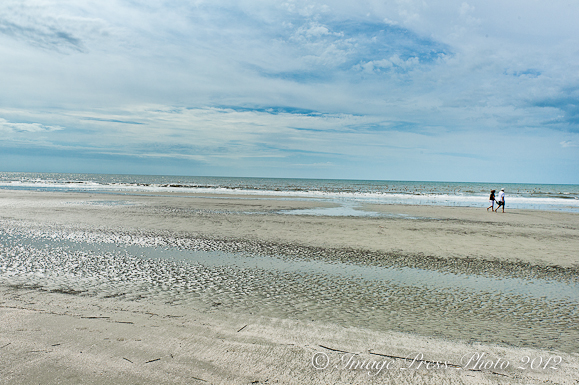
Kiawah’s beaches are rated some of the most beautiful beaches in the country
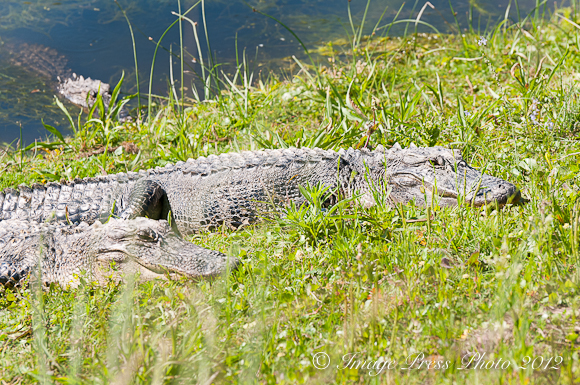
Residents and guests on the island coexist with the alligators living in their natural habitat
We first met with Robert Wysong, Executive Chef and Director of Food and Beverage at The Sanctuary. As we strolled the grounds and Chef Wysong discussed the development of the property from its inception, I was most impressed with his respect for the natural surroundings at Kiawah. Wysong and the culinary team have translated the developer’s vision of cohabiting with the environment into a culinary perspective where they buy directly from the community of farmers, fishermen and other purveyors of local bounty.
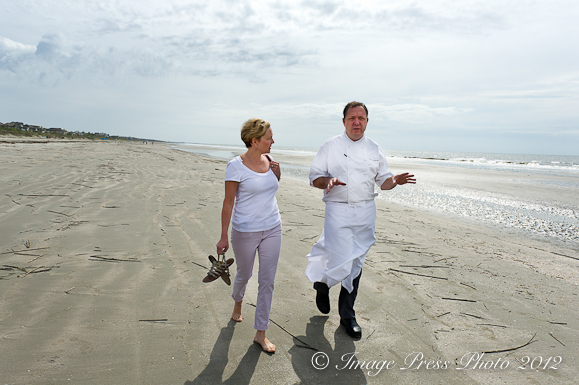
What a truly special place to work as a chef
“Buying local just makes the most sense.” With so many natural resources and an almost year-round growing season, this is the perfect environment to support local producers. By eliminating the middle man, they are able to reduce their carbon footprint, lower their distribution costs and provide their guests with the freshest and best tasting products.
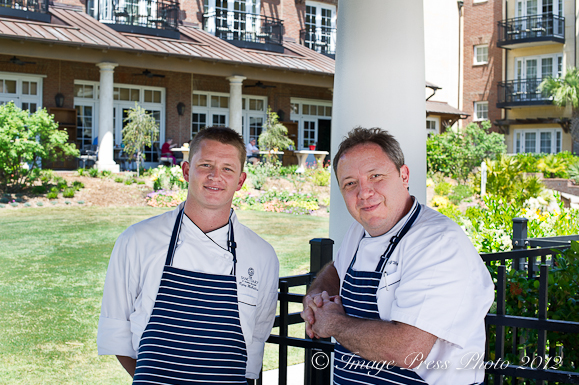
Chefs Ryley McGillis and Robert Wysong
We sat poolside at Loggerhead Grill with Chef Wysong and Ryley McGillis, Chef de Cuisine of Jasmine Porch and Loggerhead Grill (both at The Sanctuary), on our first full day at Kiawah to discuss their philosophy and how their operations work. “It was much different when I was coming up through the ranks.” Chef Wysong said, “We used to see a large truck deliver our products in blue and white boxes. Now we have crates delivered from our local farmers, fishermen and other providers with what is fresh and available on that day.” This is a win-win for the guests, the community and the chefs.
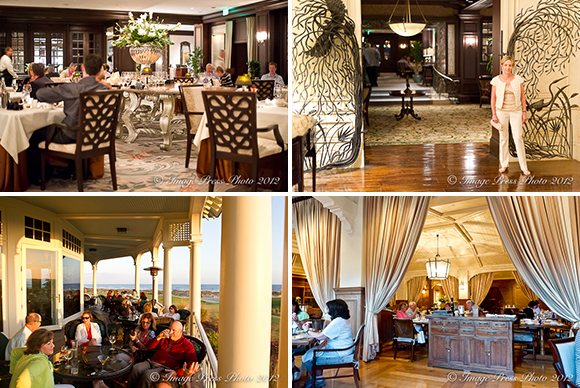
The Ocean Room, The Atlantic Room and Jasmine Porch
Chef McGillis added, “People want to support local. It is beneficial to the community. While it is much less expensive for me to buy farm-raised shrimp from South America, I will take measures somewhere else to keep costs in line. We need to support the shrimping boats that come in off the coast and not sacrifice all that we have here. We want to educate the guests to know where it comes from and how it was raised. If I keep buying from Cherry Point (a local marina), they will continue to bring in better fish and the guests will benefit. It is a concern for me at home, too.”
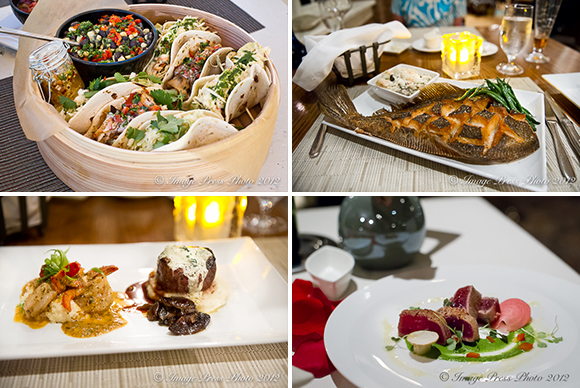
Dishes from Loggerhead Grill, Jasmine Porch and The Ocean Room
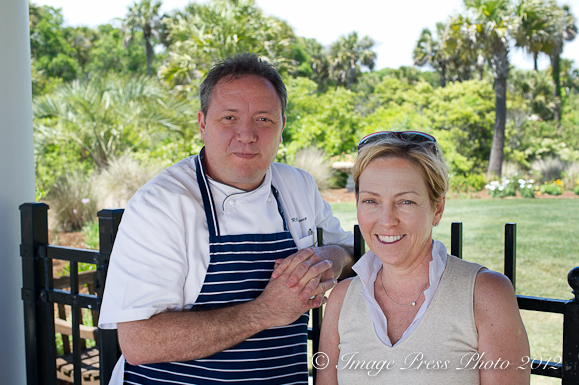
With Chef Wysong at Loggerhead Grill
Our second day at Kiawah was spent with Executive Chef Brian McGowan, who oversees the island’s restaurants outside The Sanctuary, and Chef Jason Cote of Cherrywood BBQ (more to follow on Chef Cote.) We toured the island and visited a few local purveyors. Our first stop was to check on the daily catch at Cherry Point Seafood. This marina, located on Wadmalaw Island, supplies much of the seafood for the resort. The Atlantic Room (at The Ocean Course on Kiawah Island) specializes in seafood and is also a member of the Sustainable Seafood Initiative.
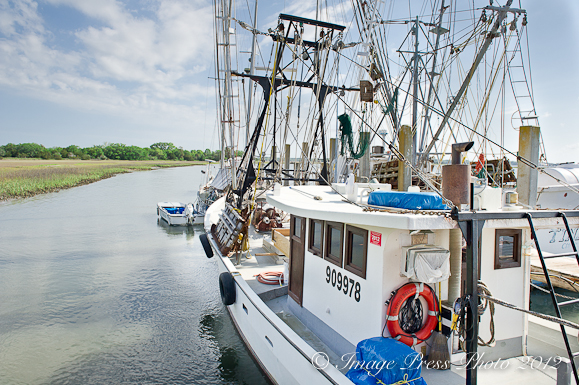
One of the fishing boats at Cherry Point Seafood
Olliver Burwell, owner of Cherry Point Seafood, frequently updates the chefs on the arrival of boats coming in to the marina with their catches. The chefs will then drive to the marina to buy fresh seafood. Fishermen like Bo Bjorn (who we met at the docks), have been fishing these waters since 1982. Bo will take his boat out for two to three weeks at a time and travel as far as Canada in search of the best fishing opportunities. Locally, he is able to catch swordfish (season opened May 1st), Mahi Mahi and yellowfin tuna, all line caught and not netted.
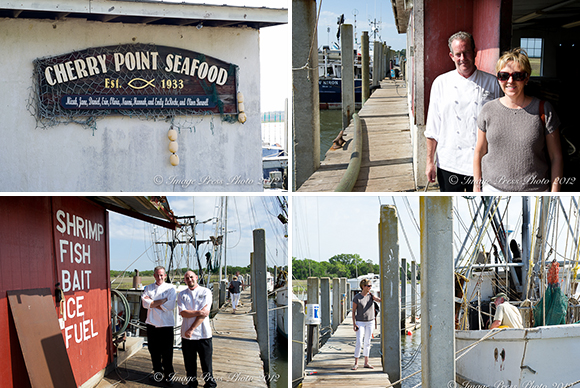
Cherry Point Seafood
On this day we found John Cooksey, a local shrimper since 1970, working on his nets. A man teetering around his 70‘s, he was hard at work preparing for his next trip. John will venture into the South Carolina and Georgia coastal waters for three to four days at a time. In the off season his catch will run between 200-300 pounds of shrimp per day. In the summer he will harvest about 1,000 pounds of shrimp per day. John has left South Carolina a few times during his life to try his luck in Key West, Florida and Texas, but as he says, “People are making a living on the water in this area. The chefs and restaurants are here because people come to see the history (in Charleston) and the island. It all works. Home is South Carolina and I always come home.”
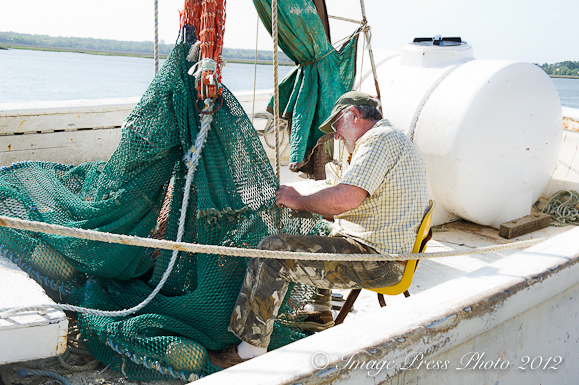
John Cooksey, a local shrimper
After leaving the docks at Cherry Point Seafood, we stopped at Ambrose Farm, one of several local farms that supply Kiawah Island resort with fresh produce. Pete Ambrose owns 130 acres with two-thirds planted in 30 different crops. The remaining land is used to produce compost which feeds the farm land rather than using artificial fertilizers.
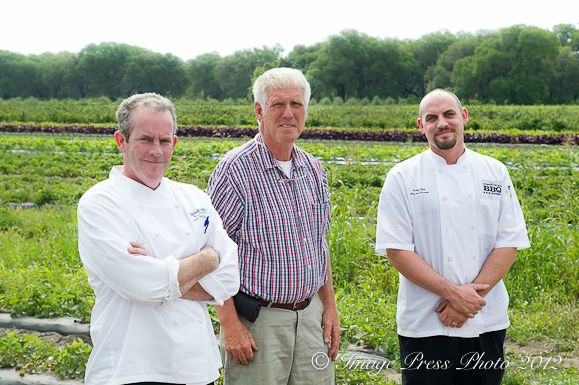
Chef Brian McGowan, Pete Ambrose and Chef Jason Cote
Ambrose Farms sells to 25 local restaurants in addition to their CSA (1,000 members). With three growing seasons, they employ 15 people at the farm and also own Stono Farm Market and the Tomato Shed Cafe. If you travel to Kiawah, stop on John’s Island at their cafe and enjoy a piece of their award-winning Tomato Pie (in season, of course).
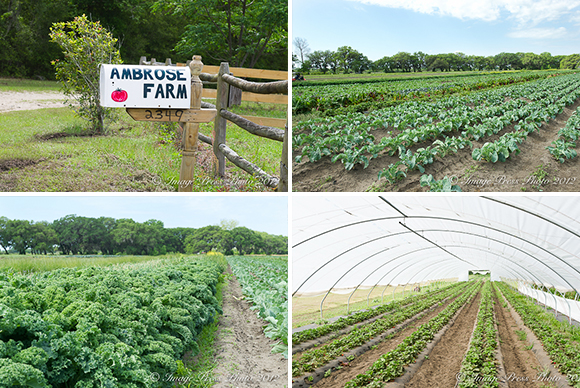
Ambrose Farm
Our last stop of the day was to Mingo Point with Chef Brian McGowan. Kiawah developers have created a venue at this location by the Kiawah River for pubic oyster roasts and barbecues. It is also a beautiful setting for private resort functions. The wood-burning grills built for this venue were made locally. If you travel to Kiawah, be sure to catch the sun setting over the marshes at Mingo Point. It is spectacular.
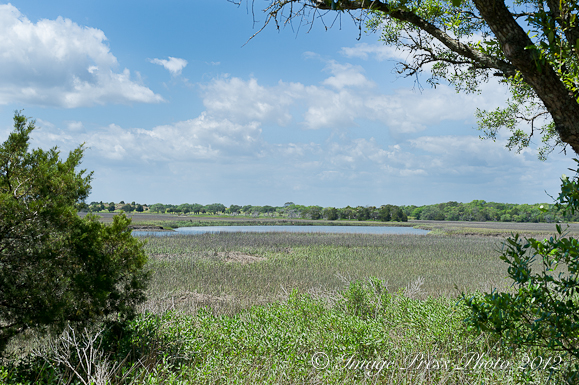
Mingo Point at the Kiawah River
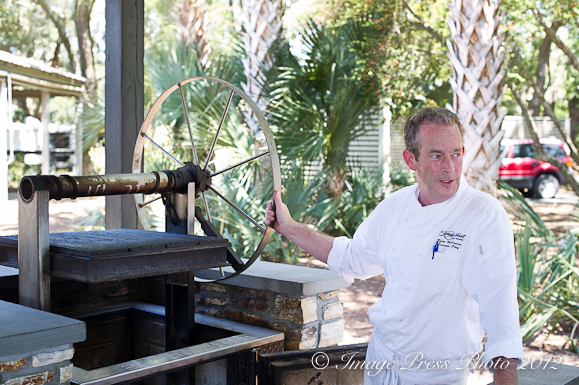
Chef Brain McGowan with the wood-burning grills at Mingo Point
It is not always easy to support local farms and producers when operating a larger scale operation like Kiawah Island Golf Resort. It takes more effort, coordination and expense to source smaller amounts of food from more places. The culinary team and the developers are committed to being responsible members of the community by preserving the natural beauty and bounty of this very special place.
Thank you so much to Chefs Wysong, McGillis, McGowan and Cote for taking time out of your busy schedules to work with us. We enjoyed spending time with you and getting to meet some of your local suppliers.
Chef McGillis has agreed to share his recipe for this gorgeous dish, Palmetto Quail. Jasmine Porch is known for its Lowcountry specialties and Palmetto Quail is a guest favorite at the restaurant. In this video, Chef McGillis gives us the step-by-step instructions and also shares some cooking and plating tips. Mr. B caught a few moments of us on tape before we thought he was recording. Geez… 😉
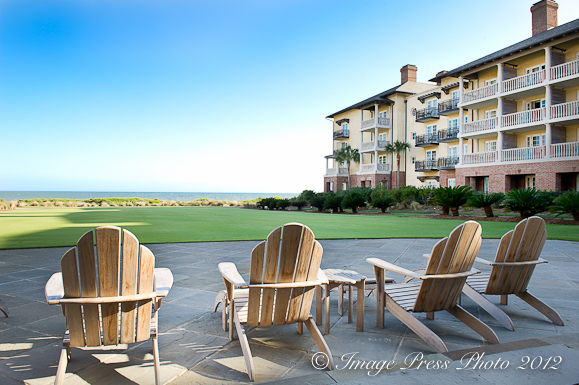
Life’s a beach at Kiawah Island
Disclosure – Kiawah Island Golf Resort provided a media package for our visit. I was not asked to write any articles about my stay and have in no way been compensated. The opinions expressed regarding our experience are my own.
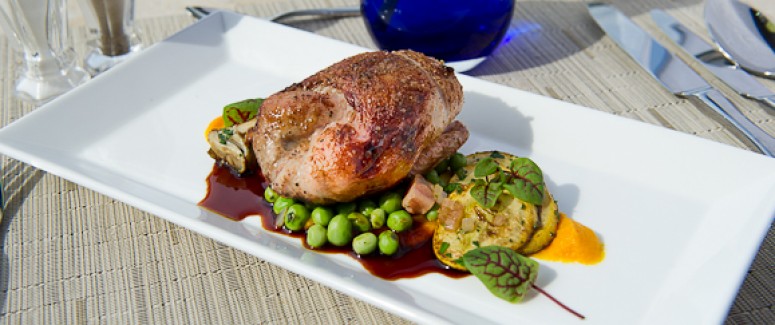
Palmetto Quail
This beautiful dish is a guest favorite and Lowcountry specialty at Jasmine Porch, one of the restaurants in The Sanctuary at Kiawah Island Golf Resort in South Carolina.
Ingredients:
Quail:
4 each 3.5 oz semi-boneless quail
1 quart brioche, small diced and toasted in the oven
2 each large shallot, brunoise
1/2 each carrot, brunoise
1 each carrot, peeled and roughly chopped (for puree)
1 each leek, minced
1 tablespoon tarragon, minced
1 tablespoon chive, finely chopped
1 tablespoons basil, chiffonade
2 tablespoons parsley, minced
1/2 each teaspoon celery seed
4 each smoked ham hock, (meat picked from bone)
1 tablespoon diced Tasso ham (smoked sausage can be substituted if necessary)
1 cluster Oyster mushroom (cremini or shiitake may be substituted if necessary)
1 gallon chicken stock (recipe below)
6 ounces chicken reduction sauce (recipe below)
1/2 cup each English peas, blanched (frozen sweet peas may be substituted if necessary)
1 each yellow squash, sliced .5” thick
1 each lemon, juiced
Chicken Stock
3 pounds chicken wings, roasted in oven for 30 minutes @ 400 degrees
2 each carrots, peeled and chopped
2 each large onions, peeled and chopped
3 each leeks, peeled, cleaned and chopped
1 sachet bay leaf, peppercorn, parsley, thyme
4 tablespoons tomato paste
Directions:
Chicken Stock:
Add all ingredients to a heavy gauge pot and cover with cold water. Bring to 200 degrees and turn heat to low while constantly skimming. Simmer for 3 hours. Strain through cheese cloth and reserve.
Chicken Reduction Sauce:
Place 3/4 gallon of chicken stock in a heavy gauge pot. Over medium heat reduce by 70% or until the sauce coats the back of a spoon, season with salt if necessary.
Stuffing:
Place a small amount of oil in a medium sized sauté pan and begin to slowly render the ham hock meat. Remove from pan and add the half of the shallot, the brunoised carrot, and leek. Sauté on low until aromatic, 2-3 minutes. Add the toasted brioche and begin to ladle the chicken stock into the mixture (about 4-5 oz) or until moist. Season with salt, pepper, celery seed, and herbs. Chill.
Carrot Puree:
Place the roughly chopped carrot in a sauce pan and barely cover with chicken stock. Simmer until completely tender. Remove the carrots from the cooking liquid and place in a blender. Pour a small amount of the cooking liquid in the blender with the carrots and puree until smooth (add as much liquid as necessary to puree). Season and reserve.
Quail:
Pat the quail dry. Lightly season the cavity of the quail with salt and pepper. Stuff and tie with butchers twine. Season with salt and pepper. With enough oil to coat the bottom of a heavy gauge sauté pan, caramelize all sides of the quail. Place in a 350 degree oven and roast to an internal temperature of 150 degrees.
Vegetables:
Over moderately high heat caramelize the squash and mushrooms. Once caramelized add the tasso ham. Render briefly (30 seconds..be sure that there is a little bit of oil for the tasso to render in). Add shallots and cook for 10 seconds more. Deglaze with the lemon juice. Add blanched peas and ladle 2-3 oz of chicken stock into the vegetables. Add the remainder of the herbs, season with salt and pepper, and set aside.
Plating
Drag a tablespoon of carrot puree down the center of the plate. Place the squash on one side of the carrot puree and the caramelized mushrooms on the other. Spoon the pea, Tasso ham, and shallot mixture in the middle. Place the quail on top and spoon 1.5 oz of the reduction sauce on the plate. Serve.
Recipe courtesy of Chef Ryley T. McGillis
Chef de Cuisine at Jasmine Porch and Loggerhead Grill
The Sanctuary
Kiawah Island, S.C.